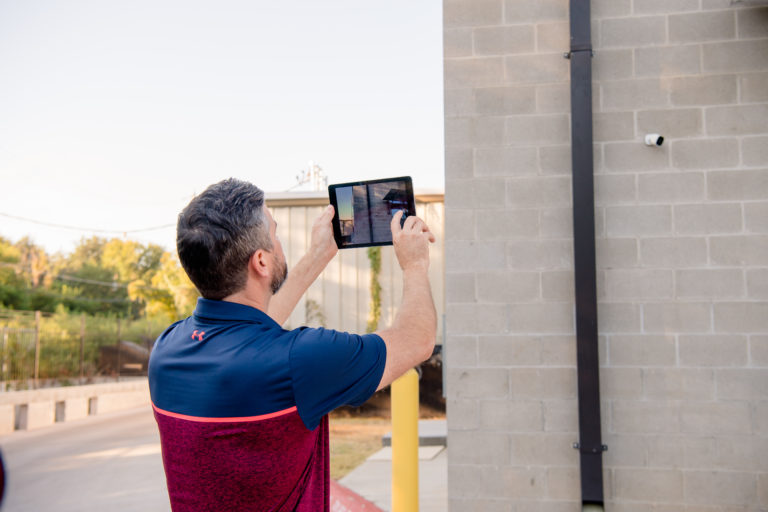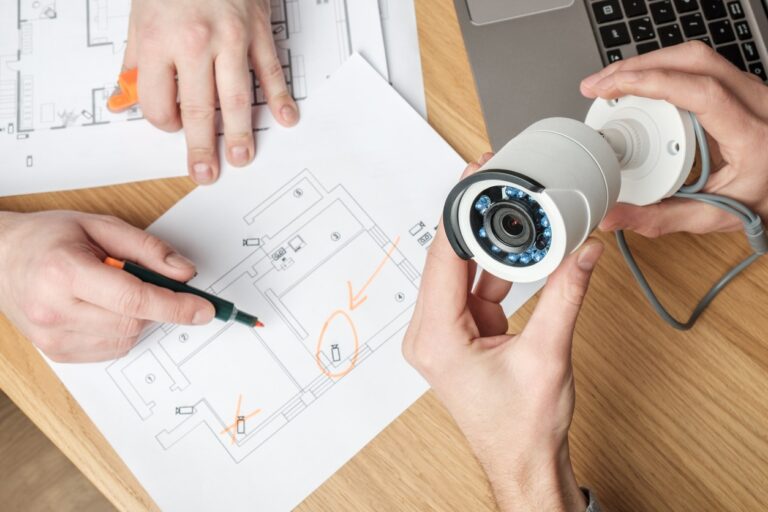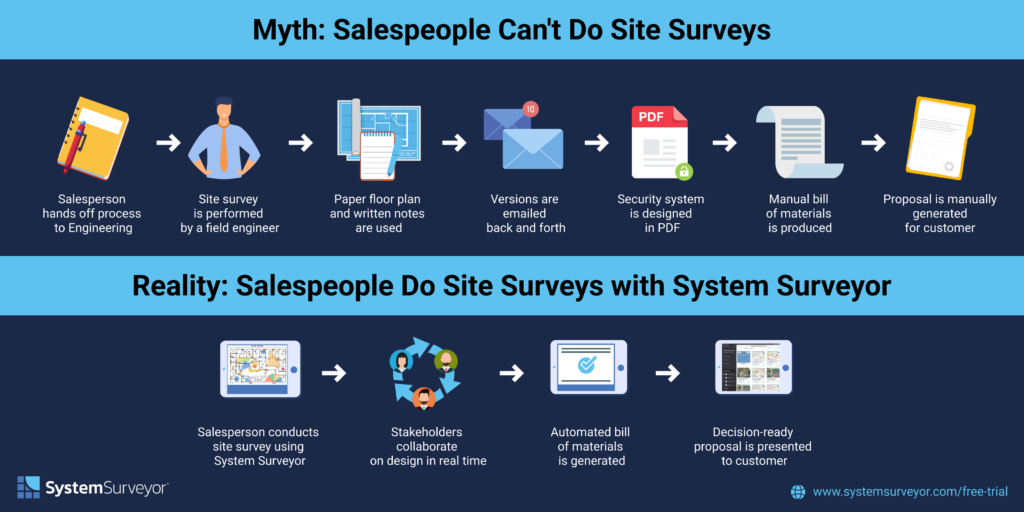Table of Contents
There are plenty of opinions out there in the security system design community, especially among system integrators. They are often based on a lot of experience over decades but some of them have created some myths if you look at today’s environment with new technologies, changing customer expectations and an evolving workforce.
Now we don’t want to step on any toes here, but there’s something everyone in this industry needs to know: some of the strong opinions out there on performing site surveys and designing integrated security systems are based more on myth than reality. And if you continue down the road of believing these myths, you run the risk of avoidable inefficiencies, unhappy customers, and fewer sales.
So, in this month’s blog post, we’re breaking down 7 common myths about site surveys and system design. For each one, we’ll discuss why the myth persists, what’s wrong with the myth, and what reality has to say on the topic.
Let’s get started with a big one: “I can do it in my head.”

Myth #1: “I can do it in my head!”
One myth we hear from system integrators — especially from successful veterans — is that site surveys aren’t all that complicated. In fact, they say, it’s easy to keep track of them mentally and write down the details later on.
Reality: Work gets in the way
This may sound good at first, but here’s the reality for most system integrators: you went to the site survey meeting at 9 am, give or take. You walked the site, talked with the client about the security measures they want, took some notes on a napkin or yellow pad, got interrupted by another client or a sales call, and then it was lunch time. You pick up some lunch and then finally head back to the office. You get to your computer around 1:30 or 2 pm — and you’re inundated with a half a day’s worth of emails you need to triage.
Finally, you’ve caught up. Now it’s time to write down those details about where to put devices for intrusion detection, access control and video surveillance. But now it’s been some five or six hours since you started doing the site survey in your head! How many details could get dropped in that amount of time? We all love that restaurant server who can take an order for 10 people and still deliver, but they are the exception to the rule.
Reality: Requires experience, and even then…
The “do it in my head” approach only works for your experienced staff. New hires can’t work this way. And even for the staff that can get decent results this way, there are still gaps and missing information for the company. It’s not foolproof. And any mental mistakes here prolong the process and string things out with the client.
Reality: Technology doesn’t forget
Last, humans forget stuff. Even the really, really good ones. But technology doesn’t. So, the right technology can help bridge that gap: embracing today’s technology (like our digital collaborative design platform) gives you superpowers compared to what can be done mentally or by recall. And those superpowers translate into better customer satisfaction and winning more sales. Our take is human + technology win, not one or the other.

Myth #2: “Paper, pen and cellphone pics will suffice.”
Tracking everything mentally doesn’t work (at least not well). The next default mode is jotting down notes on paper and snapping some cellphone pictures for placement of new equipment during the site walk.
We get it: this is a really popular approach. Some readers might be channeling their inner Mandalorian and chanting, “This is the way.”
Even still, we disagree.
Reality: Paper notes have gaps
When you take notes on paper, you’re limited to what you can draw or scribble down as you go. You’re not able to work from a to-scale floor plan. Moreover, there is a perception issue and missed opportunity with the customer who would love a bit of real visualization of what they will get (the sooner the better).
And those cellphone pictures tend to lack context when you get back to the office because let’s face it: most industrial, educational, and office buildings tend to look similar throughout. Finding IMG001.jpg on your phone in a hallway later is tricky to associate to the device needed. So, a picture being worth a thousand words gets lost in the shuffle.
Reality: A digital as-built is better
When you work from a digital floor plan and set the scale, you can start building a visual, dynamic initial design even as you walk the site. You can note what specific system types need to go in which locations, even noting specific camera field and depth. Hand that mobile tablet to your customer (which you can’t do with notes) and ask them to show the area of coverage needed for a camera. This happens every day – talk about building confidence.
Compared to paper notes, it’s hardly a fair fight.

Myth #3: “My process is repeatable.”
We all know how important a repeatable process is if you want to scale your business in the long term. And it could be that your current process feels or seems repeatable.
But is it really?
Reality: Repeatable doesn’t mean foolproof
Manual processes may be repeatable, but how easy is it to inadvertently skip steps, do tasks in a different order (maybe even because the customer asked you to), and so forth? When you stick to written operationalized or digitized processes, you can ensure repeatability better than with manual processes.
Reality: Process is by definition repeatable
Site surveys are process-oriented, and one pain point we see among growing system integrators is that every integrator (and every rep within an integrator) does things just a bit differently. Training the new hire gets complicated because no one is sure what the “official” process even is. One uses Google Slides, the other uses paper and pen, another uses PPT. Processes are consistent, red-flag if your team captures and conducts a site survey or site walk 10 different ways
The reality is, no matter what your process looks like, you still need the same baseline information in your site survey. Using a digital site survey tool gives you a repeatable process — one that your team can stick to.

Myth #4: “It’s not a big deal that everyone at our company does it differently!”
Here’s another persistent myth: that it doesn’t actually matter what process people use as long as they get the sale.
Reality: How can you scale or measure effectiveness?
Without a defined process that everyone follows, how will your business scale? How will you measure effectiveness? If someone’s numbers are lagging, is it because of some deficiency, or are they just using the wrong process?
The truth is, without uniform, repeatable processes, you can’t project manage. You can’t grow— at least not as efficiently as you could have. Moreover, it is possible that sales are happening that are not even profitable. If the downstream operations team is not clear on estimation and what was sold, it can be a money-loser, not winner.
Getting everyone on the same page is vital, but it’s not easy. One System Surveyor customer, Matrix-NDI, recognized this need. On the front end, Matrix-NDI aspired to digitize and standardize its site survey and proposal/design process. Each staff person used different, conventional methods for gathering customer requirements (e.g., pencil and paper). Of course, these can be time consuming, error prone, and complicates hand-offs between departments.

Matrix-NDI found System Surveyor to be the security solution to systematizing, unifying, and digitizing their processes. Read the full case study to see how.
Myth #5: “My customer expects the site survey to be fast and I don’t have time for a digital survey.”
This is one of the most common myths. Because site surveys have been done so manually, the customers often don’t value them very much. It is their normal to-date. The sales rep feels a bit overwhelmed and rushed. But, the myth is that customers expect this for sure. Well, of course since you have not shown them what great looks like and have not reset the expectations on the value of taking a bit more time and how they will get to visualize the site survey together. No wonder!
Reality: Actionable, accurate results matter more than up-front speed
We understand this concern — both from the SI and the customer’s point of view. But this concern only occurs with customers who have never seen what “good” looks like.
What would it do for your sales process and for your customer’s confidence if you could deliver a decision-ready proposal from the get-go? If you could shorten the overall process and massively increase accuracy?
Answer: very good things, right?
Reality: Customer re-education is possible—and positive
Here’s where you may need to engage in a little customer re-education and amazing expectation setting. If a customer seems concerned about the amount of time you need for the site survey, say something like this:
“I’m going to deliver an actionable, decision-ready site survey, and you’ll have it in hand far faster than we’ve ever been able to deliver before. The first step will take a little bit longer, and I may have more questions for you than you’re used to. But if you stick with me through this first step, the results are going to blow you away. In fact, you’ll be able to see some initial system design together with me, I promise it is worth an hour versus 20 minutes.”
Do this and you’ll become in the top tier of sales consultants!
Myth #6: “Salespeople can’t do site surveys.”
In larger SI businesses, salespeople tend to hand off a sale to a field engineer or an overlay expert/center of excellence for the site survey. This is certainly a good fit for some companies, but it might be a mistake to assume that salespeople can’t ever do a site survey to baseline capture of information at the earliest point of the process. Could they provide more value there and be more consultative without being an engineer?
Reality: The right tools make all the difference
If you have good technology and tools, then it’s almost like giving your salespeople a “site survey wizard.” There’s much less guesswork and intuition and a whole lot more actual data collected.
One System Surveyor client has already empowered its salespeople to conduct accurate site surveys:
“With tablets in hand, Securitronics (now TSI, Inc.) salespeople arrive on site ready to visually collaborate with their customers. They can collect all details right in the system. For example, a salesperson can determine a client’s needs for video surveillance and show potential placement of cameras and coverage area. They can even choose the right cameras for each application.”
Myth #7: “My customer doesn’t mind waiting weeks for a proposal and decision.”
This myth relates to all the previous ones. Your customer may say they don’t mind waiting…but what happens when someone gives them the option of not waiting?
Look back at your recent lost sales. How many of them did you lose because you were first to the table? How many because a competitor got in the door first?
As the saying goes, “time kills deals”.
Reality: The status quo is changing
The reality here is that the status quo is changing. Your competitors have access to better, newer ways of operating. If they suddenly gain the ability to undercut you by several weeks — and their first draft is more accurate, too — you’re going to take a big hit.
Wouldn’t it be better to be the one delivering faster and more accurately — and winning sales as a result? That’s best-in-class customer service.
Digital is Faster, More Accurate, and Wins More Profitable Sales

It’s all a myth now. Upgrading to a digital security system design platform like System Surveyor helps you win more profitable sales by being faster and more accurate throughout the entire sales cycle. From the initial site survey early in the customer journey to a decision-ready security system design and all the way through installation, you’ll be ahead of the curve. System Surveyor automates a bill of materials, sets the scale of the client’s floor plan, and gives you the power to build real-time, accurate systems in a collaborative digital environment.
